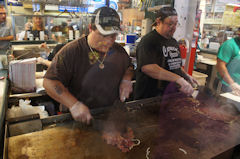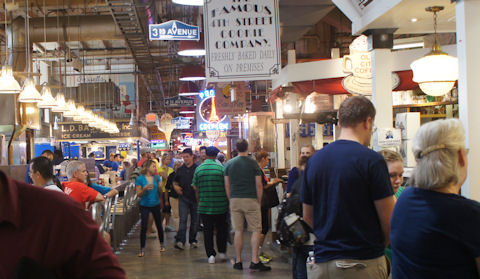When the Bacon family visited Philadelphia this weekend to watch the Eagles play the Baltimore Ravens, there was only one thing I wanted out of the trip. I had to chow down on an authentic Philadelphia cheesesteak sandwich. I’d tasted ersatz cheesesteak hoagies in Virginia but that was like ordering grits… in Connecticut. Or hamburgers… in Spain. (Trust me, I’ve tried the latter, and it doesn’t work.) I craved the real thing.
As it turns out, you can’t walk 20 feet in downtown Philly without bumping into a restaurant or food cart that sells the sandwiches. But I had the good fortune to purchase mine from Carmen’s Famous Italian Hoagies and Cheesesteaks. Not only is Carmen’s arguably the Maxim’s of the junk food world, it was located in the Reading Terminal Market, which is surely one of the busiest indoor food courts in the western hemisphere. Originating as a farmer’s market, the Market has evolved into something more: a popular tourist destination and fun place for native Philadelphians to hang out.

Making cheesesteaks is an assembly-line process at Carmen's. When all you do eight hours a day is prepare hoagies and cheesesteaks, like these two guys, you get reaalllly good at it.
My half hour wait in line was worth the delayed gratification. Loaded with peppers, onions, mushrooms and Cheese Whiz — yes, Cheese Whiz is an indispensable ingredient, or so I was informed — my sandwich fully lived up to expectations. The popularity of Carmen’s and cheesesteaks generally also helped explain why Philadelphia has the highest obesity rate of America’s largest cities.
The Philly Cheesesteak is a relic of the city’s glorious industrial past. These days, the knowledge-intensive Philadelphia region, with all of its universities and law schools, is being overrun with foodies and health nuts. Sunday morning, a half-marathon outside our downtown hotel attracted thousands of runners. The two sit-down restaurants where we ate served only organic food. And there is a major government-civic effort afoot to attack the city’s “food deserts” by inducing its ubiquitous corner markets to stock fresh fruit and vegetables.
My takeaway from Philadelphia for Virginia is this: Farmers markets are sprouting everywhere. That’s understandable: People love food and they love watching other people. Grocery shopping becomes a social event. It may be tempting to fashion a particular “vision” for these markets. Don’t. Let them evolve naturally in line with the character of the regions and neighborhoods they serve. In the Reading Terminal Market, Carmen’s coexists with Wan’s Seafood and an Amish dairy. There are sellers of herbs, purveyors of chocolates, cutters of flowers and vendors of free-range poultry. The result is culinary chaos — and a lot of fun.
The beauty of the Reading Terminal Market is that it has a roof and four walls, which provides a sense of permanence and encourages merchants to invest in counters, lighting, signage and displays that draw more patrons. Its location in a highly walkable, mixed-use downtown district also encourages loads of foot traffic. (Much of the traffic at Carmen’s was carry-out.) There are no national food chains there — all businesses are local and contribute to the regional economy. That’s a great business model for enterprising Virginia developers to emulate.



